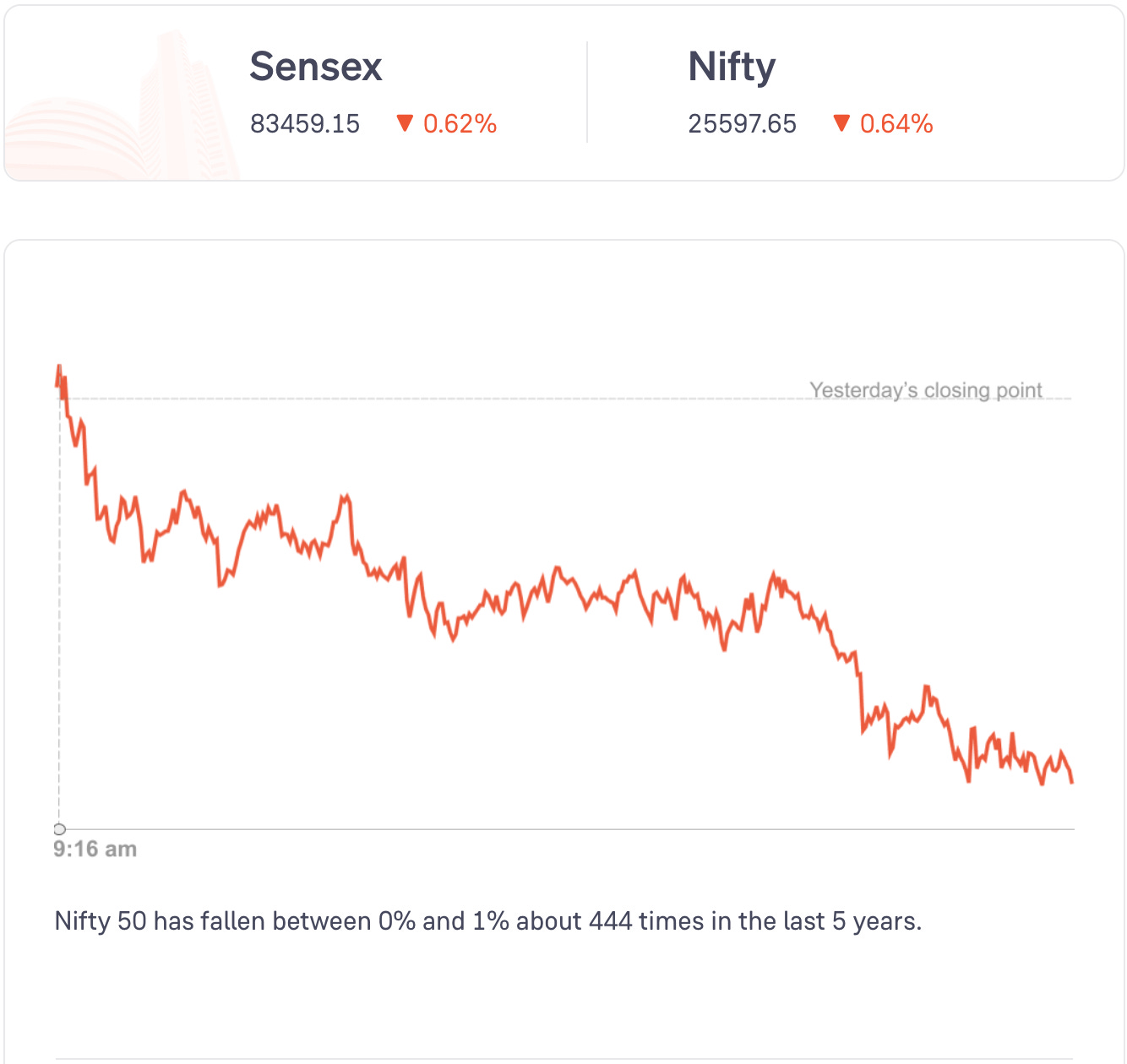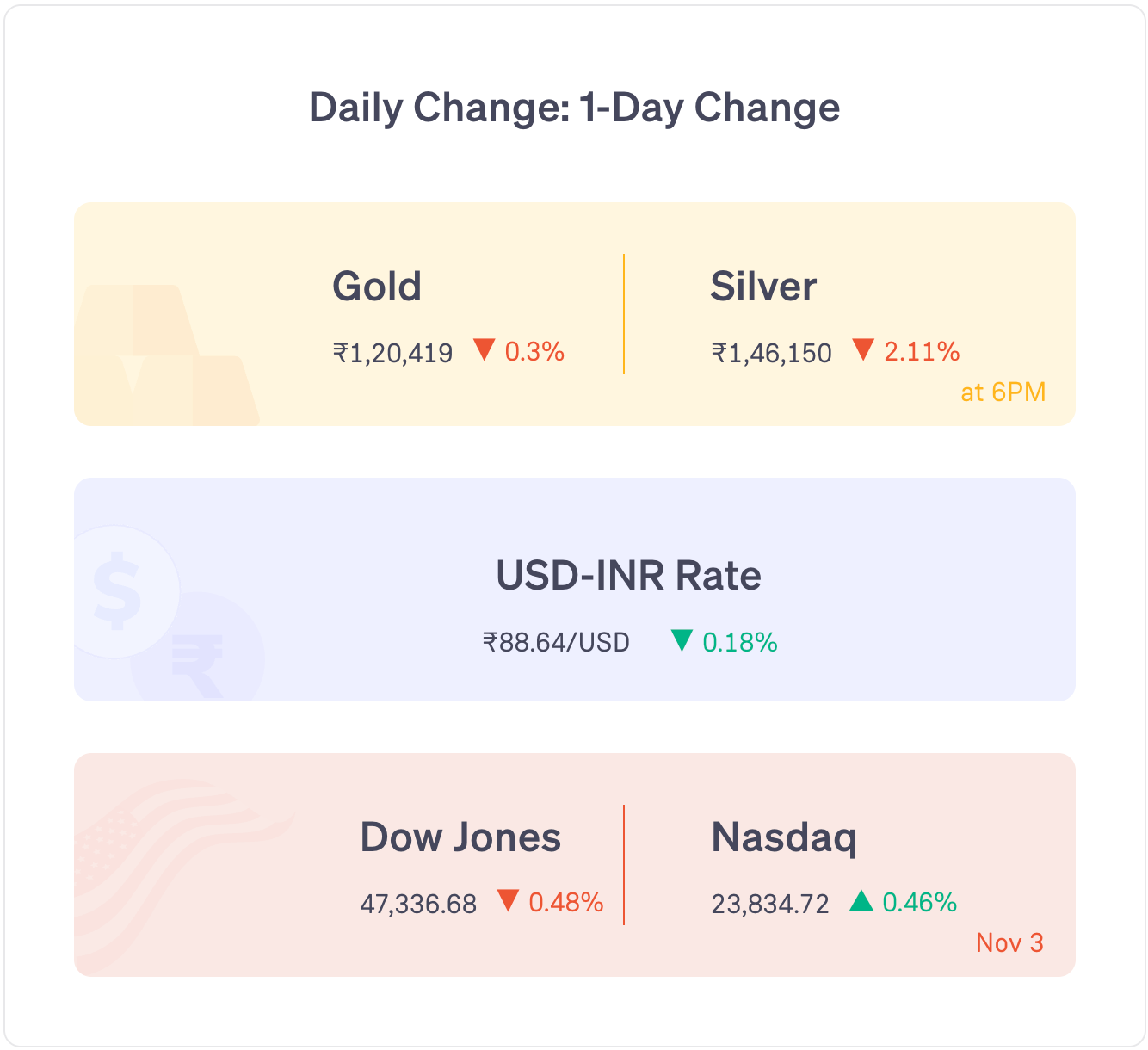Meesho IPO approved, Suzlon profits up 529%, SBI profits up 7%, & more - Groww Digest
Tuesday, 4 November 2025
Markets opened slightly above yesterday’s closing point.
Nifty 50 fell throughout the day and closed in the red.
All sectors’ stocks fell today except for the consumer durables stocks. Metal stocks and IT stocks fell the most.
Global markets: Most US markets rose. Asian markets and European markets fell (as of 6 pm IST).
News
India and the EU have advanced the negotiations about the India-EU Free Trade Agreement (FTA).
Meesho received SEBI’s approval for a Rs 4,250 crore IPO.
Shiprocket received SEBI’s approval for an IPO.
Lenskart IPO was subscribed 28.26 times. Retail subscription: 7.54 times. IPO is closed for subscription.
Note: we will not be covering any news related to the Groww IPO till the listing date (12 Nov) due to legal/conflict-of-interest reasons#
Stocks Updates
SBI: net profit rose 7% year-on-year to Rs 21,137 crore in the July-Sept quarter. Net NPAs fell to 0.42% (from 0.53% last year).
M&M: net profit rose 16% year-on-year to Rs 3,673 crore in the July-Sept quarter.
Adani Ports: net profit rose 27% year-on-year to Rs 3,109 crore in the July-Sept quarter.
Adani Enterprises: net profit rose 84% year-on-year to Rs 3,199 crore in the July-Sept quarter. It will also raise up to Rs 25,000 crore via a rights issue.
InterGlobe (IndiGo): net loss rose 162% year-on-year to Rs 2,582 crore in the July-Sept quarter.
Indian Hotels: net profit fell 49% year-on-year to Rs 285 crore in the July-Sept quarter.
Suzlon Energy: net profit rose 529% year-on-year to Rs 1,279 crore in the July-Sept quarter.
Waaree Energies: company subsidiary, Waaree Forever Energies, will acquire 100% stake in Sunbreeze Ninth Cloud.
Word of the Day
De-dollarisation
It is when countries move to reduce their dependence on the US dollar
This means using their own currency or other alternatives for international trade or foreign exchange reserves, making them less dollar dominated.
Countries do this to protect themselves from risks like US sanctions, exchange rate volatility, and dependence on the US financial system.
They also want to strengthen their own currency and be financially independent.
Example: countries like China and Russia are increasingly settling trade in their own currencies.
Their central banks are diversifying their foreign reserves by holding more gold, Euro, or other currencies.
6 Day Course
Theme: credit interest cycles
Day 2: Tuesday
The interest rate set by the central bank dictates the interest rates of most loans and deposits.
This is a key tool in every central bank’s toolkit.
They use this power to increase/decrease the supply of money in the economy.
When interest rates are lower, people tend to borrow more money and spend it buying goods and services.
This results in higher economic activity — more sales, more profits for businesses, more income, etc.
Higher economic activity is desirable. But a downside of it is inflation.
When too much money enters the economy, demand shoots up. Increased demand leads to higher prices.
Central banks across the world carefully increase and decrease the interest rates based on whichever is more relevant.
If inflation is increasing too much, they increase interest rates and reduce the supply of money in the economy.
If economic activity is low, they reduce the interest rates to increase the supply of money.
Featured Question
“How Index update regularly I mean what was the matrix”
An index is usually rule based.
For example, the Nifty 50 index is based on the rule that it will be made up of the 50 biggest companies in India.
Companies’ value changes every day.
Some companies become bigger, some become smaller.
So, the list of companies that are the 50 biggest companies on the National Stock Exchange (NSE) keeps changing from time to time.
Therefore, Nifty 50 needs to be routinely updated.
In case of Nifty 50, the rule followed is twice a year.
The Nifty 50 is updated based on the latest company sizes (market cap or m-cap) in the end of March and end of September.
Usually, 2-3 new companies enter Nifty 50 and 2-3 companies exit Nifty 50 during this reshuffle.
Similarly, other indices have different rules and are updated at different points in time.
Example: Sensex 30 is updated 2 times — June and December.
The rule it follows is that it is made up of the 30 biggest companies on the Bombay Stock Exchange (BSE).
Did you like this edition?
Leave a feedback here!





